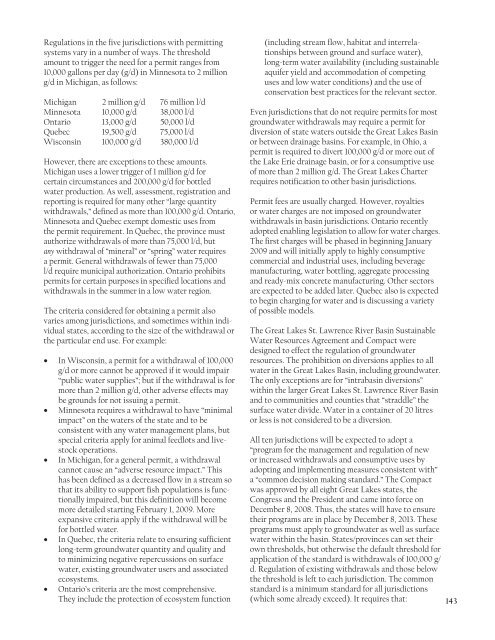Groundwater in the Great Lakes Basin
Groundwater in the Great Lakes Basin
Groundwater in the Great Lakes Basin
Create successful ePaper yourself
Turn your PDF publications into a flip-book with our unique Google optimized e-Paper software.
Regulations <strong>in</strong> <strong>the</strong> five jurisdictions with permitt<strong>in</strong>g<br />
systems vary <strong>in</strong> a number of ways. The threshold<br />
amount to trigger <strong>the</strong> need for a permit ranges from<br />
10,000 gallons per day (g/d) <strong>in</strong> M<strong>in</strong>nesota to 2 million<br />
g/d <strong>in</strong> Michigan, as follows:<br />
Michigan 2 million g/d 76 million l/d<br />
M<strong>in</strong>nesota 10,000 g/d 38,000 l/d<br />
Ontario 13,000 g/d 50,000 l/d<br />
Quebec 19,500 g/d 75,000 l/d<br />
Wiscons<strong>in</strong> 100,000 g/d 380,000 l/d<br />
However, <strong>the</strong>re are exceptions to <strong>the</strong>se amounts.<br />
Michigan uses a lower trigger of 1 million g/d for<br />
certa<strong>in</strong> circumstances and 200,000 g/d for bottled<br />
water production. As well, assessment, registration and<br />
report<strong>in</strong>g is required for many o<strong>the</strong>r “large quantity<br />
withdrawals,” def<strong>in</strong>ed as more than 100,000 g/d. Ontario,<br />
M<strong>in</strong>nesota and Quebec exempt domestic uses from<br />
<strong>the</strong> permit requirement. In Quebec, <strong>the</strong> prov<strong>in</strong>ce must<br />
authorize withdrawals of more than 75,000 l/d, but<br />
any withdrawal of “m<strong>in</strong>eral” or “spr<strong>in</strong>g” water requires<br />
a permit. General withdrawals of fewer than 75,000<br />
l/d require municipal authorization. Ontario prohibits<br />
permits for certa<strong>in</strong> purposes <strong>in</strong> specified locations and<br />
withdrawals <strong>in</strong> <strong>the</strong> summer <strong>in</strong> a low water region.<br />
The criteria considered for obta<strong>in</strong><strong>in</strong>g a permit also<br />
varies among jurisdictions, and sometimes with<strong>in</strong> <strong>in</strong>dividual<br />
states, accord<strong>in</strong>g to <strong>the</strong> size of <strong>the</strong> withdrawal or<br />
<strong>the</strong> particular end use. For example:<br />
• In Wiscons<strong>in</strong>, a permit for a withdrawal of 100,000<br />
g/d or more cannot be approved if it would impair<br />
“public water supplies”; but if <strong>the</strong> withdrawal is for<br />
more than 2 million g/d, o<strong>the</strong>r adverse effects may<br />
be grounds for not issu<strong>in</strong>g a permit.<br />
• M<strong>in</strong>nesota requires a withdrawal to have “m<strong>in</strong>imal<br />
impact” on <strong>the</strong> waters of <strong>the</strong> state and to be<br />
consistent with any water management plans, but<br />
special criteria apply for animal feedlots and livestock<br />
operations.<br />
• In Michigan, for a general permit, a withdrawal<br />
cannot cause an “adverse resource impact.” This<br />
has been def<strong>in</strong>ed as a decreased flow <strong>in</strong> a stream so<br />
that its ability to support fish populations is functionally<br />
impaired, but this def<strong>in</strong>ition will become<br />
more detailed start<strong>in</strong>g February 1, 2009. More<br />
expansive criteria apply if <strong>the</strong> withdrawal will be<br />
for bottled water.<br />
• In Quebec, <strong>the</strong> criteria relate to ensur<strong>in</strong>g sufficient<br />
long-term groundwater quantity and quality and<br />
to m<strong>in</strong>imiz<strong>in</strong>g negative repercussions on surface<br />
water, exist<strong>in</strong>g groundwater users and associated<br />
ecosystems.<br />
• Ontario’s criteria are <strong>the</strong> most comprehensive.<br />
They <strong>in</strong>clude <strong>the</strong> protection of ecosystem function<br />
(<strong>in</strong>clud<strong>in</strong>g stream flow, habitat and <strong>in</strong>terrelationships<br />
between ground and surface water),<br />
long-term water availability (<strong>in</strong>clud<strong>in</strong>g susta<strong>in</strong>able<br />
aquifer yield and accommodation of compet<strong>in</strong>g<br />
uses and low water conditions) and <strong>the</strong> use of<br />
conservation best practices for <strong>the</strong> relevant sector.<br />
Even jurisdictions that do not require permits for most<br />
groundwater withdrawals may require a permit for<br />
diversion of state waters outside <strong>the</strong> <strong>Great</strong> <strong>Lakes</strong> Bas<strong>in</strong><br />
or between dra<strong>in</strong>age bas<strong>in</strong>s. For example, <strong>in</strong> Ohio, a<br />
permit is required to divert 100,000 g/d or more out of<br />
<strong>the</strong> Lake Erie dra<strong>in</strong>age bas<strong>in</strong>, or for a consumptive use<br />
of more than 2 million g/d. The <strong>Great</strong> <strong>Lakes</strong> Charter<br />
requires notification to o<strong>the</strong>r bas<strong>in</strong> jurisdictions.<br />
Permit fees are usually charged. However, royalties<br />
or water charges are not imposed on groundwater<br />
withdrawals <strong>in</strong> bas<strong>in</strong> jurisdictions. Ontario recently<br />
adopted enabl<strong>in</strong>g legislation to allow for water charges.<br />
The first charges will be phased <strong>in</strong> beg<strong>in</strong>n<strong>in</strong>g January<br />
2009 and will <strong>in</strong>itially apply to highly consumptive<br />
commercial and <strong>in</strong>dustrial uses, <strong>in</strong>clud<strong>in</strong>g beverage<br />
manufactur<strong>in</strong>g, water bottl<strong>in</strong>g, aggregate process<strong>in</strong>g<br />
and ready-mix concrete manufactur<strong>in</strong>g. O<strong>the</strong>r sectors<br />
are expected to be added later. Quebec also is expected<br />
to beg<strong>in</strong> charg<strong>in</strong>g for water and is discuss<strong>in</strong>g a variety<br />
of possible models.<br />
The <strong>Great</strong> <strong>Lakes</strong> St. Lawrence River Bas<strong>in</strong> Susta<strong>in</strong>able<br />
Water Resources Agreement and Compact were<br />
designed to effect <strong>the</strong> regulation of groundwater<br />
resources. The prohibition on diversions applies to all<br />
water <strong>in</strong> <strong>the</strong> <strong>Great</strong> <strong>Lakes</strong> Bas<strong>in</strong>, <strong>in</strong>clud<strong>in</strong>g groundwater.<br />
The only exceptions are for “<strong>in</strong>trabas<strong>in</strong> diversions”<br />
with<strong>in</strong> <strong>the</strong> larger <strong>Great</strong> <strong>Lakes</strong> St. Lawrence River Bas<strong>in</strong><br />
and to communities and counties that “straddle” <strong>the</strong><br />
surface water divide. Water <strong>in</strong> a conta<strong>in</strong>er of 20 litres<br />
or less is not considered to be a diversion.<br />
All ten jurisdictions will be expected to adopt a<br />
“program for <strong>the</strong> management and regulation of new<br />
or <strong>in</strong>creased withdrawals and consumptive uses by<br />
adopt<strong>in</strong>g and implement<strong>in</strong>g measures consistent with”<br />
a “common decision mak<strong>in</strong>g standard.” The Compact<br />
was approved by all eight <strong>Great</strong> <strong>Lakes</strong> states, <strong>the</strong><br />
Congress and <strong>the</strong> President and came <strong>in</strong>to force on<br />
December 8, 2008. Thus, <strong>the</strong> states will have to ensure<br />
<strong>the</strong>ir programs are <strong>in</strong> place by December 8, 2013. These<br />
programs must apply to groundwater as well as surface<br />
water with<strong>in</strong> <strong>the</strong> bas<strong>in</strong>. States/prov<strong>in</strong>ces can set <strong>the</strong>ir<br />
own thresholds, but o<strong>the</strong>rwise <strong>the</strong> default threshold for<br />
application of <strong>the</strong> standard is withdrawals of 100,000 g/<br />
d. Regulation of exist<strong>in</strong>g withdrawals and those below<br />
<strong>the</strong> threshold is left to each jurisdiction. The common<br />
standard is a m<strong>in</strong>imum standard for all jurisdictions<br />
(which some already exceed). It requires that:<br />
143

















